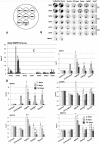The effect of biological sealants and adhesive treatments on matrix metalloproteinase expression during renal injury healing
- PMID: 28494022
- PMCID: PMC5426796
- DOI: 10.1371/journal.pone.0177665
The effect of biological sealants and adhesive treatments on matrix metalloproteinase expression during renal injury healing
Abstract
Background: Renal injuries are relatively common in cases of abdominal trauma. Adhesives and sealants can be used to repair and preserve damaged organs. Using a rat model, this study explores the activity of different matrix metalloproteinases (MMP) during the healing of renal injuries treated by two biological adhesives (TachoSil and GelitaSpon) and a new synthetic elastic cyanoacrylate (Adhflex).
Methods: Renal traumatic injuries were experimentally induced in 90 male Wistar rats by a Stiefel Biopsy Punch in the anterior aspect of the left kidney. Animals were divided into five groups: 1, sham non-injured (n = 3); 2, non-treated standard punch injury (n = 6); 3, punch injury treated with TachoSil (n = 27); 4, punch injury treated with GelitaSpon (n = 27); and, 5, punch injury treated with Adhflex (n = 27). Wound healing was evaluated 2, 6, and 18 days after injury by determining the expression of MMPs, and the histopathological evolution of lesions.
Findings: Histologically, the wound size at 6 days post-injury was larger in Adhflex-treated samples than in the other treatments, but the scarring tissue was similar at 18 days post-injury. Only the MMPs subtypes 1, 2, 8, 9, and 13 were sufficiently expressed to be quantifiable. Both time since injury and treatment type had a significant influence on MMPs expression. Two days after injury, the expression of MMP8 and MMP9 was predominant. MMP2 expression was greater 6 days after injury. The Adhflex-treated group had a significantly higher MMPs expression than the other treatment groups at all healing stages.
Conclusions: All three sealant treatments induced almost similar expression of MMPs than untreated animals indicating a physiological healing process. Given that all renal trauma injuries must be considered emergencies, both biological and synthetic adhesives, such as Adhflex, should be considered as a treatment options.
Conflict of interest statement
Figures


References
-
- Butt MU, Zacharias & Velmahos GC (2009) Penetrating abdominal injuries: management controversies. Scand J Trauma Resusc Emerg Med 17:19 doi: 10.1186/1757-7241-17-19 - DOI - PMC - PubMed
-
- Johnson WK, Kelel KM, Hollenbeck BK, Daignault S, Wolf JS Jr (2006) Acute integrity of closure for partial nephrectomy: comparison of 7 agents in a hypertensive porcine model. J Urol 175(6): 2307–11. doi: 10.1016/S0022-5347(06)00282-5 - DOI - PubMed
-
- Kim SH, Kim SH, Cho JY (2009) Cyst ablation using a mixture of N-butyl cyanoacrylate and iodized oil in patients with autosomal dominant polycystic kidney disease: the long-term results. Korean J Radiol. 10(4): 377–83. doi: 10.3348/kjr.2009.10.4.377 - DOI - PMC - PubMed
-
- Pursifull NF, Morey AF (2007) Tissue glues and nonsuturing techniques. Curr Opin Urol. 17(6):396–401. doi: 10.1097/MOU.0b013e3282f0d683 - DOI - PubMed
-
- Haas CS, Gleason B, Lin S, Tramonti G, Kanwar YS. (2004) Matrix metalloproteinases in renal development. Connect Tissue Res.45(2):73–85. doi: 10.1080/03008200490442644 - DOI - PubMed
MeSH terms
Substances
LinkOut - more resources
Full Text Sources
Other Literature Sources
Miscellaneous

